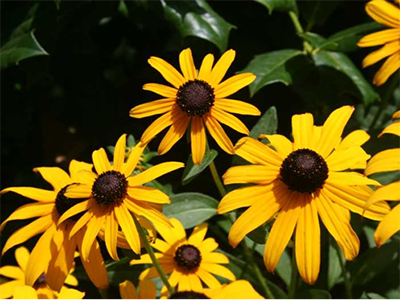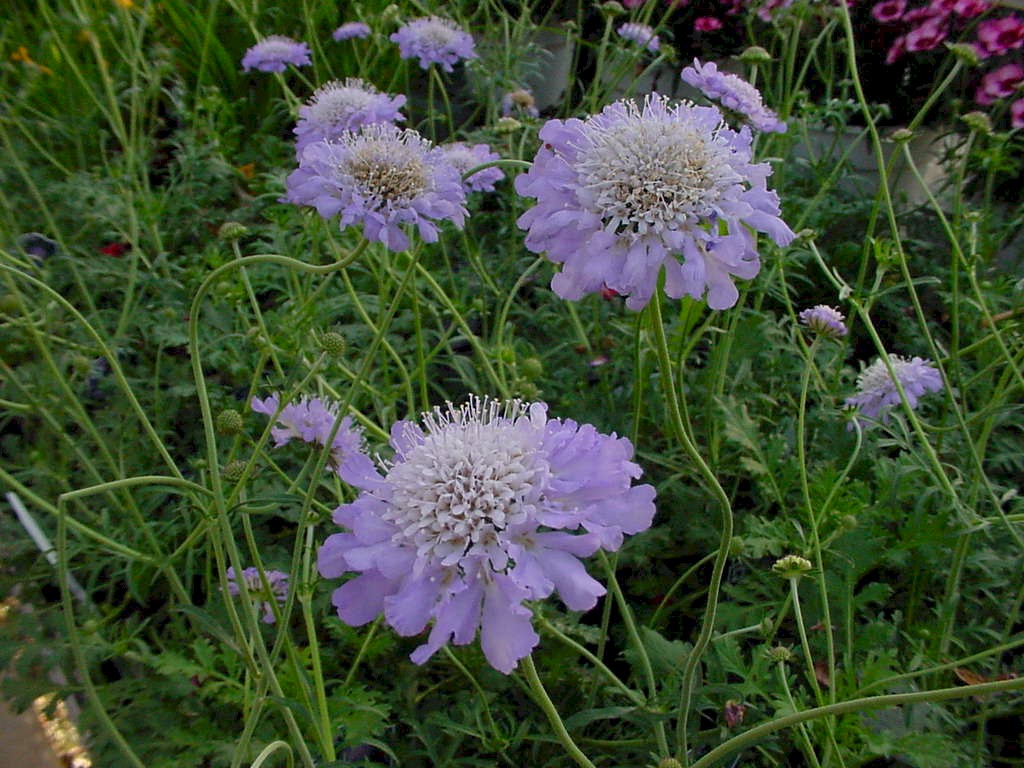Rudbeckia Fulgida Goldsturm

Rudbeckia fulgida var. Sullivantii 'Goldsturm'.
| Rudbeckia fulgida | |
|---|---|
| Scientific classification | |
| Kingdom: | |
| (unranked): | |
| (unranked): | |
| (unranked): | |
| Order: | |
| Family: | |
| Genus: | |
| Species: | R. fulgida |
| Binomial name | |
| Rudbeckia fulgida | |
Rudbeckia fulgida, the orange coneflower[1] or perennial coneflower,[2] is a species of flowering plant in the family Asteraceae, native to eastern North America.
Description[edit]
It is an herbaceousperennial growing up to 120 cm (47 in) tall, with bright yellow daisy-like composite flower heads.
Growth and reproduction[edit]
R. fulgida spreads by both stoloniferous stems and seed. The seeds are produced in fruits called cypselae, which are 2.2 to 4 mm long and have short coroniform pappi, 0.2 mm long.[3]The ripe seed is a favorite food of finches in winter.
Morphology[edit]
Stems are hairy, ridged, and dark green. Leaves are dark green, sparsely but roughly haired, simple, with sparsely serrate margins. Flowers are heads, with black disk florets and bright orange ray florets, borne singly on stems that extend above the foliage. Stems are glabrous or moderately covered in hirsute hairs with spreading branches. The leaves have blades that are lanceolate to broadly ovate or elliptic in shape without lobes. The leaf bases are attenuate to cordate in shape and the margins of the leaves are usually entire or serrate, or sometimes lacerate. The upper surfaces of the leaves are glabrous or have hirsute to strigose hairs. The basal leaves are petiolate, with petioles that are 5 to 30 cm long and 1 to 8 cm wide, the cauline or stem leaves have petioles that are 2 to 25 cm long and 0.5 to 7 cm wide, the bases are attenuate to cordate or auriculate in shape.
The flower heads are often produced one per stem but are also often produced in corymbiform arrays with 2 to 7 flowers per stem. The cups that hold the flowers called receptacles, are hemispheric to ovoid in shape with paleae 2.5 to 4 mm long, the apices are obtuse to acute in shape with the ends usually glabrous and the apical margins ciliate. The flower heads have 10 to 15 ray florets with laminae elliptic to oblanceolate in shape and 15–25 cm long and 3 to 6 mm wide. The abaxially surfaces of the laminae have strigose hairs. The flower discs or center cones are 12 to 16 mm tall and 10 to 18 mm wide, made up of 50 to over 500 disc florets, with the corollas proximally yellowish green and brown-purple distally in color, 3 to 4.2 mm long, having style branches 1.3 mm long.
Etymology[edit]
Rudbeckia was named for Linnaeus' mentor, Olaus (Olaf) Rudbeck (1630-1702) and his son Olof Rudbeck (1660-1740), both professors of botany at Uppsala.[4]

Fulgida means ‘flashing' or 'glowing', and is derived from 'fulgidus', meaning 'brightly colored’.[4]
Cultivation[edit]
There are seven varieties;
- R. fulgida var. deamii (S. F. Blake) Perdue - Deam's coneflower
- R. fulgida var. fulgidaAiton - orange coneflower
- R. fulgida var. palustris (Eggert ex C.L. Boynt. & Beadle) Perdue - orange coneflower, prairie coneflower
- R. fulgida var. spathulata (Michx.) Perdue - orange coneflower
- R. fulgida var. speciosa (Wender.) Perdue - orange coneflower
- R. fulgida var. sullivantii (C.L. Boynt. & Beadle) Cronquist - Sullivant's coneflower
- R. fulgida var. umbrosa (C.L. Boynt. & Beadle) Cronquist - orange coneflower
R. fulgida var. deamii[6] and R. fulgida var. sullivantii 'Goldsturm'[7] have both gained the Royal Horticultural Society's Award of Garden Merit.[8]
Toys vs Nightmares with cheats: Keyhack G add gold, F add fantasy. Your objective in this cartoon defense game is to protect to boy from the nightmares by casting toys to defend each row from the monsters. Place units on the field to battle the enemies and complete waves. Play Toys Vs Nightmares – From ArcadePrehacks.com. Strategic-defense funny game, mobile ready, with mini-game preloader! As a frightened kid, exploit your toys to oppose to the nightmare monsters popping out from your wardrobe! Toys vs nightmares download. My most viewed video on youtube with 3.5k views ^^.
Vernalization is beneficial to flower initiation. Recommendations are listed below:
- 'Goldsturm' - 10–12 weeks at 40 °F [9][10]
- 'Little Goldstar' - 10 weeks below 40 °F [11][12]
- 'Pot of Gold' - 10 weeks at 35-41 °F [13]
References[edit]
| Wikiversity has bloom time data for Rudbeckia fulgida on the Bloom Clock |
- ^'Rudbeckia fulgida'. Natural Resources Conservation Service PLANTS Database. USDA. Retrieved 25 October 2015.
- ^'BSBI List 2007'. Botanical Society of Britain and Ireland. Archived from the original(xls) on 2015-01-25. Retrieved 2014-10-17.
- ^Rudbeckia fulgida in Flora of North America @ efloras.org
- ^ abGledhill, David (2008). 'The Names of Plants'. Cambridge University Press. ISBN9780521866453 (hardback), ISBN9780521685535 (paperback). pp 172, 335
- ^ITIS Report: Rudbeckia fulgida Aiton
- ^'RHS Plant Selector - Rudbeckia fulgida var. 'deamii''. Retrieved 3 July 2013.
- ^'RHS Plant Selector - Rudbeckia fulgida var. sullivantii 'Goldsturm''. Retrieved 3 July 2013.
- ^'AGM Plants - Ornamental'(PDF). Royal Horticultural Society. July 2017. p. 93. Retrieved 11 October 2018.
- ^'Rudbeckia fulgida, Goldsturm, Perennial Benary'. www.benary.com. Retrieved 2016-12-27.
- ^'Jelitto Perennial Seed RUDBECKIA fulgida var. sullivantii 'Goldsturm' Portion(s)'. www.jelitto.com. Retrieved 2016-12-27.
- ^'Perennial Solutions: Rudbeckia 'Little Goldstar' – Greenhouse Product News'. www.gpnmag.com. Retrieved 2016-12-27.
- ^'Rudbeckia fulgida var. sullivantii 'Little Goldstar' - Greenhouse Management'. Greenhouse Management. Retrieved 2016-12-27.
- ^'Rudbeckia fulgida 'Pot Of Gold' – Greenhouse Product News'. www.gpnmag.com. Retrieved 2016-12-27.
Black-eyed Susan (Rudbeckia fulgida var. Sullivantii 'Goldsturm') is a plant that quickly becomes two, three or even 10 through division or natural reseeding in the course of a few seasons. Icycle. The clump-forming, fast-growing perennial, suitable for U.S. Department of Agriculture plant hardiness zones 3 through 9, blooms in fall with golden petals around a deep-brown, cone-shaped center.
Though it has the specific cultivar name 'Goldsturm,' the plant is not patented, so it is not illegal to propagate or even sell the new plants you raise. Propagating 'Goldsturm'Goldsturm' freely reseeds in the garden when you don't deadhead spent flowers consistently. 'Goldsturm' is considered a stable cultivar and does reproduce true from seed.
Seed started indoors needs prechilling, called stratification, before germinating at 72 degrees Fahrenheit. Unless seeds are exposed to three to four weeks at 32 to 35 degrees F, they may not bloom well in their first season. Since the plant spreads through rhizomes, which are underground stems, to form new clumps, 'Goldsturm' can be dug up and separated into new plants in spring or fall. Patented PlantsWhen you purchase a plant labeled with a patent number or 'Plant Patent Applied For' after the cultivar name, propagating new plants though divisions or cuttings is a no-no. While the 'plant police' won't show up on your doorstep - and if they do, there are no consequences if you are not selling the plants - you should have a twinge of conscience. Breeders who hold patents receive royalties for each plant sold from nurseries licensed to grow their varieties.
Patents are intended to encourage the introduction of new plants to the market by making it more rewarding for plant breeders to develop new varieties. While the terms of a plant patent protect the variety from uncompensated asexual propagation for 20 years, plants can be propagated by the seeds the flowers produce and by using its pollen to fertilize other plants to create new hybrids, which are unlikely to resemble the patented parent plant. Patented Rudbeckia VarietiesWhile unpatented 'Goldsturm' is fair game for asexual propagating, there are patented black-eyed Susan cultivars derived from 'Goldsturm' that without a license can only be legally propagated by seed. These include 'Early Bird Gold,' which blooms in midspring; 'Pot of Gold,' which grows 20 to 24 inches tall and has larger flowers than 'Goldsturm'; and 'Little Goldstar,' which grows only 14 to 16 inches tall with a slightly smaller flower than its parent. Varieties are suitable for USDA zones 4 through 9.